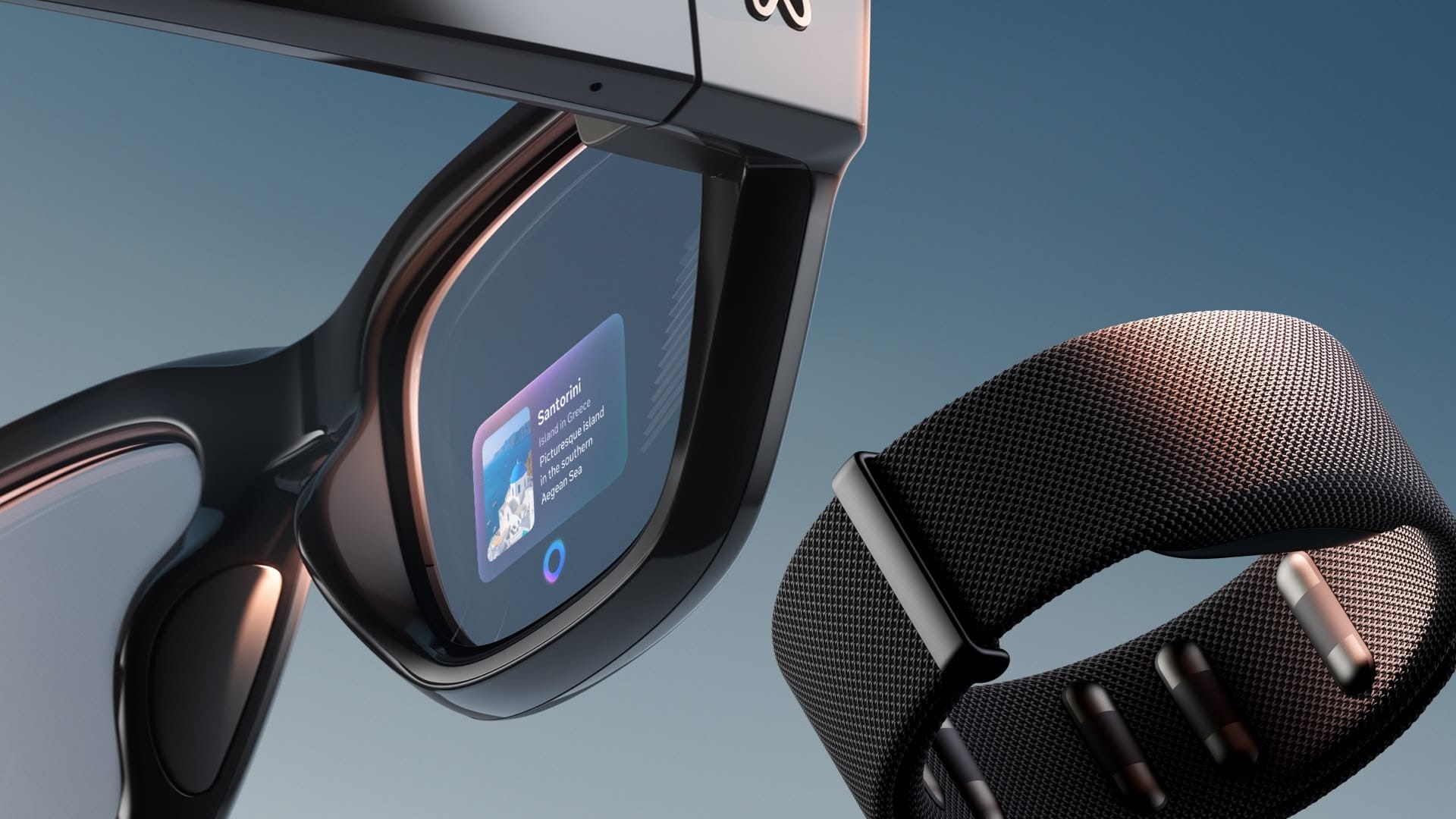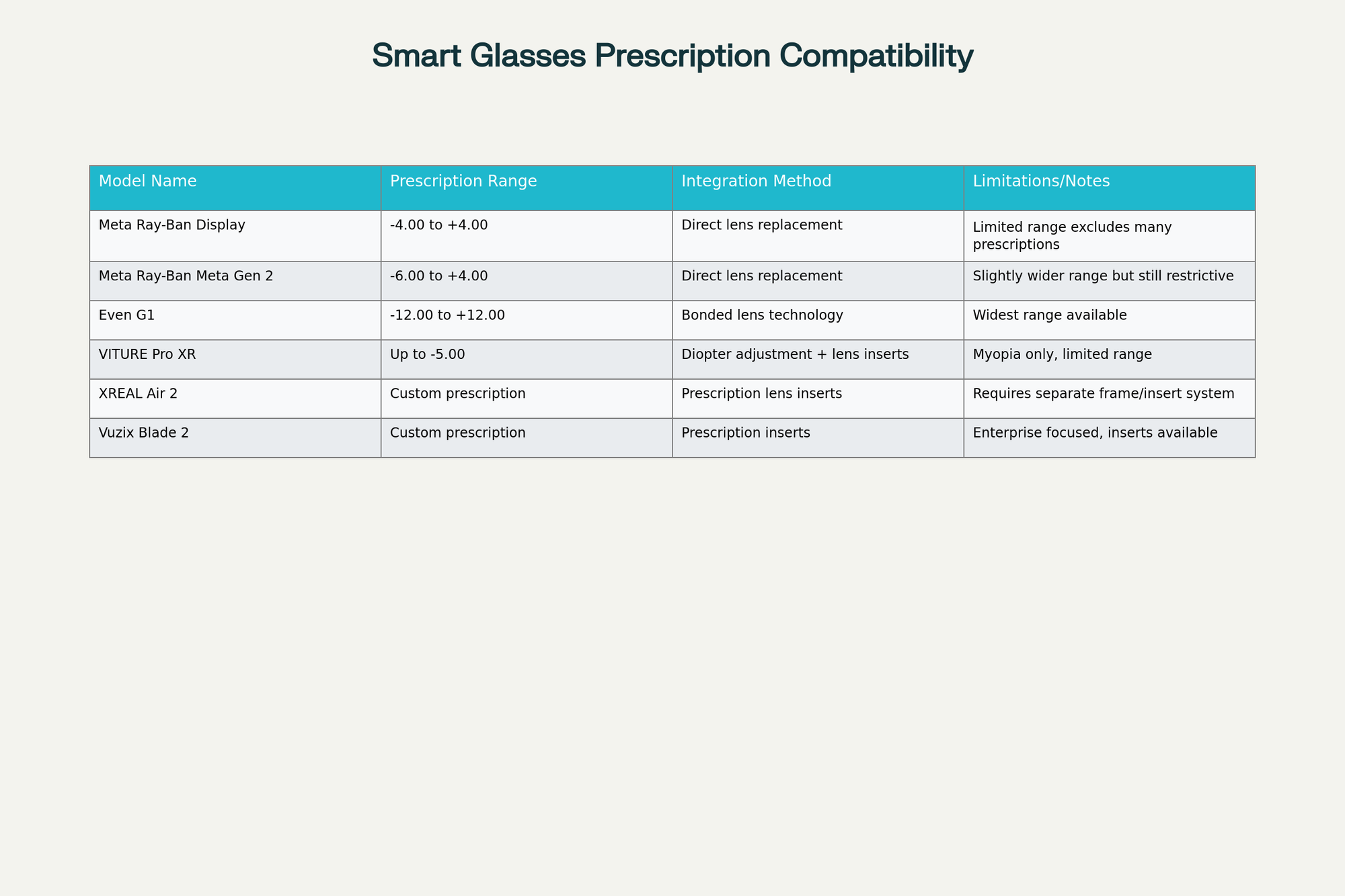Smart Glasses with Built-in Displays: The Prescription Challenge and Alternative Solutions

The emergence of smart glasses with integrated displays, exemplified by Meta's new Ray-Ban Display glasses, represents a significant leap forward in wearable technology. However, these innovative devices face a critical limitation that affects a substantial portion of potential users: prescription compatibility. This technical analysis explores the constraints imposed by current smart glasses technology on users with vision correction needs and examines promising alternatives that could democratize access to augmented reality displays.
The Current State of Prescription Limitations
Meta Ray-Ban Display: The New Benchmark with Restrictions
Meta's recently announced Ray-Ban Display glasses, priced at $799, showcase impressive technical capabilities including a 600×600 pixel full-color display with 90Hz refresh rate and 5,000 nits brightness. However, they come with a significant constraint: prescription support is limited to -4.00 to +4.00 total power. This represents a notable improvement over the original Ray-Ban Meta glasses, which only supported -6.00 to +4.00.
For users whose prescriptions fall outside this range, the implications are severe. As one user with -8.00 refraction noted, "Meta's newest glasses won't work for me". This limitation affects not only those with high myopia but also users with complex prescriptions requiring prism correction or severe astigmatism.
The Broader Industry Prescription Landscape
The prescription compatibility issue extends across the smart glasses industry, though with varying degrees of accommodation:

Smart Glasses Prescription Compatibility Comparison
Even G1 stands out as the most prescription-friendly option, supporting an impressive range of -12.00 to +12.00 diopters through their proprietary bonded lens technology. This approach integrates prescription correction directly into the optical system rather than using separate inserts.
VITURE Pro XR glasses offer diopter adjustment up to -5.00D but require separate prescription lens frames for more complex prescriptions. XREAL Air 2 relies entirely on prescription lens inserts, which can be challenging to source and install properly.
Why Smart Glasses Have Prescription Limits
Physical Constraints of Waveguide Displays
The fundamental challenge stems from the physics of waveguide-based display systems. These systems direct light from micro-displays through optical waveguides embedded in the lens material to create the augmented reality overlay. Adding corrective optics disrupts this carefully calibrated optical path.
As noted in technical documentation, "In a waveguide-based system, prescription correction can only be addressed by adding corrective optics, matched to the user's prescription. Not only does this make size and weight goals very difficult to achieve, as well as significantly increasing cost, it complicates a brand's go-to-market strategy".
Manufacturing and Integration Challenges
Current smart glasses face several technical hurdles when accommodating prescriptions:
- Thickness limitations: High-prescription lenses require significant thickness, conflicting with the slim profile needed for embedded electronics
- Weight distribution: Adding prescription optics creates front-heavy designs that compromise comfort
- Optical alignment: Maintaining precise alignment between display elements and corrective lenses across different prescriptions
- Manufacturing complexity: Each prescription requires custom optical engineering, dramatically increasing production costs
Alternative Display Technologies: Breaking Free from Prescription Constraints
Retinal Projection Systems
Direct retinal projection represents one of the most promising approaches for eliminating prescription dependencies. These systems project images directly onto the retina, bypassing the eye's natural focusing mechanism entirely.
However, current retinal projection systems face their own challenges:
- Extremely accurate pupil tracking requirements
- Eye safety concerns with laser-based systems
- Visible scan patterns during eye movement
- Complex manufacturing requirements
Holographic Display Technology
Holographic displays offer another pathway to prescription-independent AR. Companies like Swave Photonics are developing Holographic eXtended Reality (HXR) technology that uses computational approaches rather than optical complexity.
Key advantages of holographic displays include:
- Computational prescription correction: Vision correction achieved through software rather than hardware
- Wide field of view: Not constrained by traditional waveguide limitations
- Natural accommodation: Can present images at multiple focal distances simultaneously
- Slim form factor: Eliminates bulky optical components
Computational Vision Correction
Emerging research in prescription-aware rendering shows promise for completely eliminating the need for corrective optics. This approach modifies the displayed image in real-time to compensate for the viewer's refractive errors.
The ChromaCorrect system demonstrated significant improvements by:
- Modeling user-specific point spread functions using Zernike polynomials
- Optimizing display output in perceptually-guided color spaces (LMS)
- Achieving prescription correction through pure software approaches
- Supporting myopia, hyperopia, and astigmatism correction simultaneously
Adaptive Optics Integration
Adaptive optics technology, originally developed for astronomy, is being adapted for consumer displays. These systems use:
- Real-time wavefront sensing to measure ocular aberrations
- Deformable mirror systems for dynamic correction
- Continuous compensation for eye movement and accommodation changes
While currently limited to research applications, miniaturization of adaptive optics components could enable smart glasses that automatically adjust to any prescription in real-time.
Smart Contact Lens Technology: The Ultimate Solution
The most radical approach to eliminating prescription limitations involves smart contact lenses with embedded displays. Companies like XPANCEO are developing AR contact lenses that promise:
- Universal prescription compatibility: Direct placement on the eye eliminates optical intermediaries
- Natural field of view: No peripheral vision restrictions
- Seamless integration: Invisible to observers, enabling natural social interaction
- Computational vision enhancement: Ability to enhance rather than just correct vision
XPANCEO has demonstrated multiple prototypes, including systems for color blindness correction and optical verification, with plans for functional prototypes by 2026.
Implications for Users with Complex Prescriptions
Current Workarounds and Limitations
Users with prescriptions beyond standard smart glasses ranges face several imperfect solutions:
- Contact lenses: Many resort to wearing contacts specifically for smart glasses use, though this introduces comfort and maintenance issues
- Third-party lens services: Companies like UseMyFrame specialize in creating high-prescription lenses for smart glasses, though this adds cost and complexity
- Prescription inserts: Some glasses support clip-in prescription frames, but these add bulk and can affect optical performance
The Vision Correction Market Reality
With over 60% of American adults requiring vision correction, the current prescription limitations represent a significant barrier to mass adoption. Users with common conditions like:
- High myopia (prescriptions beyond -6.00)
- Severe hyperopia (prescriptions beyond +4.00)
- Complex astigmatism requiring prism correction
- Presbyopia requiring progressive lenses
Are effectively excluded from the smart glasses ecosystem, limiting the technology's reach and commercial viability.
Future Outlook: Technology Convergence
Near-term Solutions (2025-2027)
- Expanded prescription ranges: Manufacturers will likely extend supported prescription ranges as display technology improves
- Better insert systems: Magnetic and clip-in prescription systems will become more sophisticated and user-friendly
- Computational correction: Software-based vision correction will begin appearing in consumer devices
Medium-term Developments (2027-2030)
- Holographic displays: True 3D holographic systems will eliminate many current optical constraints
- Adaptive optics: Miniaturized adaptive systems will enable real-time prescription adjustment
- Multi-focal displays: Displays capable of presenting sharp images at multiple distances simultaneously
Long-term Vision (2030+)
- Smart contact lenses: Commercial AR contact lenses will provide universal prescription compatibility
- Retinal interfaces: Direct neural interfaces may bypass optical systems entirely
- Computational vision enhancement: AI-powered systems will not just correct vision but enhance it beyond natural human capabilities
Recommendations for Stakeholders
For Users with Prescriptions
- Evaluate current options carefully: Test prescription compatibility before purchasing
- Consider contact lens solutions: May provide better experience than compromised optical systems
- Monitor emerging technologies: Holographic and computational approaches show promise
- Engage with specialized providers: Third-party lens manufacturers may offer solutions not available from device makers
For Manufacturers
- Invest in computational approaches: Software solutions scale better than hardware accommodations
- Develop modular optical systems: Enable easy prescription lens integration
- Partner with vision care providers: Streamline the prescription lens procurement process
- Research alternative display technologies: Move beyond current waveguide limitations
For the Industry
- Establish prescription standards: Common specifications would enable ecosystem development
- Invest in fundamental research: Support development of prescription-agnostic display technologies
- Address accessibility concerns: Ensure emerging AR technologies don't exclude users with vision needs
- Develop testing methodologies: Create standards for evaluating prescription compatibility
The future of smart glasses with built-in displays depends on solving the prescription compatibility challenge. While current devices like the Meta Ray-Ban Display represent significant progress, truly inclusive AR technology will require fundamental advances in display technology, computational vision correction, or radical new approaches like smart contact lenses. The companies and technologies that successfully address these challenges will ultimately determine the trajectory of mainstream AR adoption.
- https://www.reddit.com/r/RayBanStories/comments/1gltoq9/meta_raybans_have_prescription_limits/
- https://www.androidcentral.com/wearables/the-ray-ban-meta-smart-glasses-are-my-gadget-of-the-year-but-ill-never-wear-them-again
- https://www.meta.com/ai-glasses/meta-ray-ban-display-glasses-and-neural-band/
- https://www.meta.com/ai-glasses/prescription/
- https://www.gsmarena.com/meta_rayban_display_and_rayban_meta_gen_2_smart_glasses_debut-news-69560.php
- https://www.cnet.com/tech/computing/i-wore-metas-new-ray-ban-display-glasses-and-neural-band-i-feel-augmented/
- https://www.evenrealities.com/en-CH/g1
- https://www.reddit.com/r/Xreal/comments/1i0augu/prescription_lenses_for_xreal_air_comfort_and/
- https://academy.viture.com/xr_glasses/accessories
- https://vroptician.com/prescription-lens-inserts/nreal-air
- https://swave.io/wp-content/uploads/2024/06/Swave-AR-Requirements-Whitepaper.pdf
- https://swave.io/swave-achieves-world-first-true-color-holographic-display-with-nano-pixel-spatial-color/
- https://www.spiedigitallibrary.org/conference-proceedings-of-spie/13390/1339002/Holographic-displays-for-augmented-reality/10.1117/12.3045017.full
- https://pmc.ncbi.nlm.nih.gov/articles/PMC10191670/
- http://complightlab.com/ChromaCorrect/
- https://pmc.ncbi.nlm.nih.gov/articles/PMC9741482/
- https://eyewiki.org/Adaptive_Optics
- https://uppcsmagazine.com/smart-contact-lenses-for-ar-the-future-of-augmented-reality/
- https://builtin.com/articles/ar-contact-lens
- https://www.xrtoday.com/augmented-reality/ar-smart-contact-lenses-due-in-2026-awe-asia-2024/
- https://usemyframe.com/blogs/news/we-make-prescription-lenses-for-ray-ban-meta-even-strong-and-prism-rx
- https://www.meta.com/ch/en/ai-glasses/prescription/
- https://www.ray-ban.com/usa/c/frequently-asked-questions-ray-ban-meta-smart-glasses
- https://www.meta.com/ch/en/ai-glasses/ray-ban-meta/
- https://www.evenrealities.com/en-CH/blog/ai-prescription-glasses
- https://pharmadocx.com/regulatory-guidelines-for-wearable-technology-in-healthcare/
- https://www.meta.com/blog/meta-ray-ban-display-ai-glasses-connect-2025
- https://cybernews.com/vr-ar/best-prescription-smart-glasses
- https://www.morganlewis.com/-/media/files/publication/outside-publication/article/hlw_fdawearablemedicaltech_may2014.pdf
- https://www.roadtovr.com/meta-ray-ban-smart-glasses-display-price-release-date-specs/
- https://www.meta.com/ch/en/ai-glasses/meta-ray-ban-display
- https://pmc.ncbi.nlm.nih.gov/articles/PMC8309890
- https://moorinsightsstrategy.com/research-notes/ray-ban-meta-smart-glasses-review-better-cooler-and-more-useful-than-ever/
- https://solosglasses.com
- https://www.asus.com/ch-en/support/faq/1054069
- https://www.youtube.com/watch?v=DTLq7i6tWMk
- https://www.pcmag.com/picks/the-best-smart-glasses
- https://inairspace.com/blogs/learn-with-inair/prescription-smart-glasses-the-future-of-vision-and-technology-is-here
- https://edition.cnn.com/2025/09/18/tech/meta-ray-ban-display-ai-smart-glasses-demo
- https://pmc.ncbi.nlm.nih.gov/articles/PMC2995647/
- https://lensology.co.uk/ray-ban-meta-lenses/
- https://sid.onlinelibrary.wiley.com/doi/full/10.1002/msid.1227
- https://about.fb.com/news/2025/09/meta-ray-ban-display-ai-glasses-emg-wristband/
- https://www.theverge.com/tech/779566/meta-ray-ban-display-hands-on-smart-glasses-price-battery-specs
- https://www.sciencedirect.com/science/article/pii/S2211383524001345
- https://www.viture.com/product/prescription-lens-frame
- https://www.cnbc.com/2025/09/17/zuckerberg-799-meta-ray-ban-display-glasses.html
- https://infinityone3d.com/en/products/xreal-one-lens-adapter
- https://us.shop.xreal.com/blogs/buying-guide/prescription-lens-inserts-vs-diopter-adjustment-which-is-better
- https://smartglasseson.com/ar-smart-glasses-review-xreal-air-2-pro/
- https://www.youtube.com/watch?v=-ZhD8Dt6akY
- https://vroptics.asia/products/viture-one-xr-glasses-prescription-lenses
- https://eu.shop.xreal.com/products/xreal-air-2
- https://www.vr-rock.com/products/virtue-one-xr-glasses-prescription-lens-inserts
- https://us.shop.xreal.com/blogs/buying-guide/user-guide_xreal-one-series
- https://www.reddit.com/r/VITURE/comments/1dvew78/prescription_inserts_for_the_viture_pro_xr/
- https://sensing.konicaminolta.eu/mi-en/news/xpanceo-konica-minolta-ar-smart-contact-lenses
- https://hallidayglobal.com
- https://www.youtube.com/watch?v=LK6zHQLyt7w
- https://patents.google.com/patent/US11852813B2/en
- https://www.vuzix.com/products/vuzix-blade-2-smart-glasses
- https://patent.nweon.com/34995
- https://inairspace.com/blogs/learn-with-inair/smart-glasses-with-display-prescription-the-future-of-vision-is-here
- https://lookingglassfactory.com/lkg-go
- https://yhiroi.github.io/assets/pdf/2025_IEEEVR_HOE_Beaming.pdf
- https://www.pcmag.com/news/meta-launches-smart-glasses-with-in-lens-display-heres-what-they-can-do
- https://showstoppers.com/essnz-berlin-the-first-smart-glasses-with-prescription-for-all-day-use/
- https://www.youtube.com/watch?v=noKCqel3nks
- https://www.cnet.com/tech/computing/a-new-wave-of-smart-glasses-are-coming-but-will-they-get-better-fast-enough
- https://crstoday.com/articles/2013-may/adaptive-optics-technology-clinical-use-of-visual-simulators
- https://www.wired.com/gallery/best-smart-glasses
- https://www.bloomberg.com/news/articles/2025-09-18/meta-launches-799-glasses-with-screen-in-bid-for-mainstream-hit
- https://arxiv.org/html/2501.01450v1
- https://pubmed.ncbi.nlm.nih.gov/36823887
- https://www.nature.com/articles/s41467-024-54687-z
